Module 6 - Introduction to Electronic Emission, Tubes, and Power
Supplies
Pages i,
1-1,
1-11,
1-21,
1-31,
1-41,
1-51,
2-1,
2-11,
2-21,
2-31,
3-1,
3-11,
3-21,
3-31,
3-41,
3-51, AI-1, Index
was a variation in plate current of 7.5 milliamperes. Instead of amplification, De Forest had obtained
"conversion," or in other words, converted a signal voltage to a current variation. This wasn't exactly what he
had in mind. As it stood, the circuit wasn't very useful. Obviously, something was needed. After examining the
circuit, De Forest discovered the answer - Ohm's law. Remember E = I × R? De Forest wanted a voltage change, not a
current change. The answer was simple:

In other words, run the plate current variation (caused by the voltage on the grid) through a resistor,
and cause a varying voltage drop across the resistor. This is shown in figure 1-16.
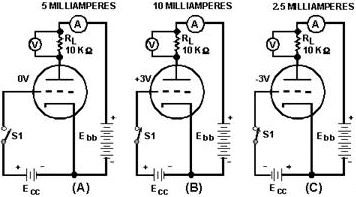
Figure 1-16. - Operation of the plate load resistor. The circuit is identical to the one in figure 1-15 except that now a resistor (called a plate-load
resistor, RL) has been added to the plate circuit, and a voltmeter has been added to measure the voltage drop
across RL. In view (A) of figure 1-16, the control grid is at 0 volts. Once again 5 milliamperes flow in
the plate circuit. Now, the 5 milliamperes must flow through RL. The voltage drop is equal to: E = I × R
E = (5 × 10-3 amperes) × (10 × 103 ohms) E = (5 × 10-3) × (10 × 10 3) E = 5 × 10
E = 50 volts Thus the voltage drop across the plate-load resistor, RL, is 50 volts when no voltage is
applied to the grid. In view (B) of the figure, +3 volts is applied to the control grid. Once again plate current
increases to 10 milliamperes. The voltage drop across RL is
1-21
E = I × R E = (10 × 10-3 amperes) × (10 × 103 ohms) E = (10 × 10-3) × (10 × 103) E = 10 × 10 E = 100 volts By applying +3 volts to the grid, the voltage drop across RL was
increased by 50 volts (from the original 50 volts to 100 volts). In view (C), -3 volts has once again been applied
to the control grid. Once again plate current decreases to 2.5 milliamperes, and the voltage drop across RL drops
to 25 volts. We have caused the voltage across RL to vary by varying the grid voltage; but is it
amplification? Well, let's take a look at it. The grid voltage, or input signal, varies from +3 to -3 volts, or 6
volts. The voltage drop across RL varies from 25 volts to 100 volts, or 75 volts. In other words, the triode has
caused a 6-volt input signal (varying) to be outputted as a signal that varies by 75 volts.
That's amplification! Q13. What is the primary difference between a diode
and a triode? Q14. Why does the grid have a greater effect than the plate on electron flow through a
vacuum tube? Q15. What component is used in a triode amplifier to convert variation in current
flow to voltage variation?
Let's summarize what you have learned so far:
· a relatively small change in voltage on the grid causes
a relatively large change in plate current.
· By adding a plate-load resistor in series with the plate
circuit, the changing plate current causes a changing voltage drop in the plate circuit.
· Therefore, the small voltage change on the grid causes a large change of voltage in the plate circuit.
· By this process, the small input signal on the grid has been amplified to a large output signal voltage in the
plate circuit. We'll leave De Forest at this point. He showed that the control grid can, in fact,
CONTROL plate current. He also showed that the changing plate current can create a changing plate
voltage. To some degree, his changing voltages and currents also changed the world. Introduction
to GRID BIAS We purposely left out several features of practical triode circuits from the
circuits we just discussed. We did so to present the idea of grid control more simply. One of these features is
grid bias.
Let's take another look at the circuit in figure 1-15(B). We found that the positive charge on the grid caused
more plate current to flow. However, when the grid becomes positive, it begins to act like a small plate. It draws
a few electrons from the space charge. These electrons flow from the cathode across the gap to the positive grid,
and back through the external grid circuit to the cathode. This flow is known as grid current. In some tube
applications, grid current is desired. In others it is relatively harmless, while in some, grid current causes
problems and must be eliminated.
1-22
Most amplifier circuits are designed to operate with the grid Negative relative to
the cathode. The voltage that causes this is called a BIAS Voltage. The symbol for the bias
supply is Ecc. One effect of bias (there are several other very important ones) is to reduce or eliminate grid
current. Let's see how it works. GRID BIAS is a steady, direct voltage that is placed at
some point in the external circuit between the grid and the cathode. It may be in the cathode leg or the grid leg
as shown in figure 1-17. It is always in series with the input signal voltage. In each of the circuits in figure
1-17, Ecc makes the grid negative with respect to the cathode because of the negative terminal being connected
toward the grid and the positive terminal being connected toward the cathode. With identical components, each
circuit would provide the same bias.
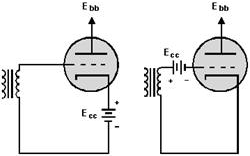
Figure 1-17. - Basic biasing of a triode. Battery bias is practically never used in modern circuits. Because of its simplicity, however, we will use it in analyzing the effects of bias. We will present other, more practical methods later. Let's assume
that the bias voltage in figure 1-17 is -6 volts. Let's also assume that the peak-to-peak signal voltage from the
transformer is 6 volts. Each of these voltage waveforms is shown in figure 1-18. From past experience you know
that voltages in series ADD. Figure 1-18 has a table of the instantaneous values of the two
voltages added together. The waveforms are drawn from these values.
1-23
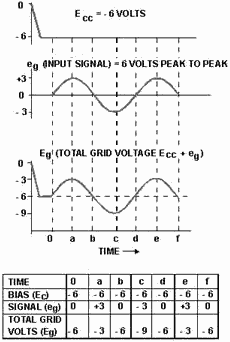
Figure 1-18. - Typical grid waveforms. Because the bias voltage is more negative than the signal voltage is positive, the resultant voltage
(bias plus signal), Eg, is ALWAYS negative. The signal, in this case, makes the grid voltage go
either
MORE or LESS Negative, (-9 to -3) but cannot drive it positive. Under
these circumstances, the negative grid always repels electrons from the space charge. The grid cannot draw
current. Any problems associated with grid current are eliminated, because grid current cannot flow to a negative
grid.
You have probably already realized that the negative bias also reduces plate current flow. (Negative charge on
grid-less plate current, right?) The trick here is for the circuit designer to choose a bias and an input signal
that, when added together, do not allow the grid to become positive nor to become negative enough to stop plate
current.
Tube biasing is very important. You will learn much more about it shortly. From this brief introduction, you
should have learned that grid bias
· is a steady, direct voltage that in most cases makes the grid
negative with respect to the cathode;
· is in series with the signal voltage between grid and cathode;
1-24
· acts to reduce or eliminate grid current;
· acts to reduce plate current from what it
would be if no bias existed;
· is produced in other ways than just by a battery; and
· is important for reasons other than those just studied. Operation of The TRIODE
The circuit in figure 1-19 brings together all of the essential components of a triode amplifier. Before analyzing
the circuit, however, we need to define the term QUIESCENT.
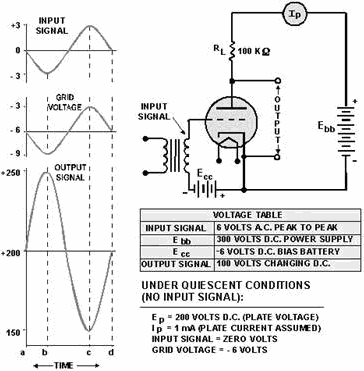
Figure 1-19. - Triode operation. The term quiescent identifies the condition of a circuit with NO Input Signal
applied. With a given tube, bias supply, and plate supply, an exact amount of plate current will flow with no
signal on the grid. This amount is known as the quiescent value of plate current. The quiescent value of plate
voltage is the voltage between cathode and plate when quiescent current flows.
1-25
Simply, quiescent describes circuit conditions when the tube is not amplifying. The tube has no output
signal and is in a kind of standby, waiting condition. Now let's go on to figure 1-19. With no input signal, under
quiescent conditions, assume that 1 milliampere of current flows through the tube, cathode to plate. This current
(Ip) will flow through RL (load resistor) to the positive terminal of the battery. The current flowing through
RL causes a voltage drop (IR) across RL equal to:

Subtracting the voltage dropped across the plate-load resistor from the source voltage of 300 volts
gives you 200 volts (300 volts - 100 volts). Thus, the plate voltage (Ep) is at 200 volts. The quiescent
conditions for the circuit are:

These values are shown on the waveforms as time a in figure 1-19. You should notice that even
though the grid is more negative (-6 volts) than the cathode, the tube in the circuit is still conducting, but not
as heavily as it would if the grid were at zero volts. Now look at the input signal from the transformer
secondary. For ease of explanation, we will consider only three points of the ac sine wave input: point b, the
maximum negative excursion; point c, the maximum positive excursion; and point d, the zero reference or null point
of the signal. At time b, the input signal at the grid will be at its most negative value (-3 volts). This will
cause the grid to go to -9 volts (-6 volts + -3 volts). This is shown at time b on the grid voltage waveform. The
increased negative voltage on the control grid will decrease the electrostatic attraction between the plate and
the cathode. Conduction through the tube (Ip) will decrease. Assume that it drops to .5 milliamperes. The
decrease in plate current will cause the voltage drop across the plate-load resistor (RL) to also decrease from
100 volts, as explained by Ohm's law:

or

Plate voltage will then rise +250 volts.

This is shown on the output signal waveform at time b. At time c, the input has reached its
maximum positive value of +3 volts. This will decrease grid voltage to -3 volts (-6 volts + 3 volts). This is
shown on the grid voltage waveform at time c. This in turn will increase the electrostatic force between the plate
and cathode. More electrons will then flow from the
1-26
cathode, through the grid, to the plate. Assume that the plate current in this case will increase to
1.5 milliamperes. This will cause plate voltage (Eb) to decrease to 150 volts as shown below.

This is shown on the output waveform at time c. At time d, the input signal voltage decreases
back to zero volts. The grid will return to the quiescent state of -6 volts, and conduction through the tube will
again be at 1 milliampere. The plate will return to its quiescent voltage of +200 volts (shown at time d on the
output waveform). As you can see, varying the grid by only 6 volts has caused the output of the triode to
vary by 100 volts. The input signal voltage has been amplified (or increased) by a
factor of 16.6. This factor is an expression of amplifier Voltage Gain and is calculated by
dividing the output signal voltage by the input signal voltage. Before going
on to the next section, there is one more thing of which you should be aware. Look again at the waveforms of
figure 1-19. Notice that the output voltage of the amplifier is 180º out of phase with the input voltage. You will
find that this polarity inversion is a characteristic of any amplifier in which the output is taken between the
cathode and the plate. This is normal and should not confuse you when you troubleshoot or work with this type of
circuit.
Q16. Why is the control grid of a triode amplifier negatively biased? Q17. For a circuit to be
considered to be in the quiescent condition, what normal operating voltage must be zero?
Q18. a triode amplifier similar to the one shown in figure 1-19 has an Ebb -350 volts dc. The plate- load
resistor is 50 kΩ. Under quiescent conditions, 1.5 milliamperes of current conducts through the tube. What will be
the plate voltage (Ep) under quiescent conditions? Q19. a 2-volt, peak-to-peak, ac input signal is
applied to the input of the circuit described in Q18. When the signal is at its
maximum positive value, 2.5 milliamperes flows through the tube. When the input is at
its maximum negative value, conduction through the tube decreases to .5
milliamperes.
a. What is the peak-to-peak voltage of the output signal? b. What is the phase relationship between
the input and output signals? Factors Affecting TRIODE Operation
The triode circuit you have just studied is a fairly simple affair. In actual application, triode circuits are a
bit more complex. There are two reasons for this. The first has to do with the triodes ability to amplify and
perform other functions. Triodes come in many different types. Each of these types has different internal
characteristics and different capabilities. Because of this, each triode circuit must be designed to accommodate
the triodes special characteristics. The second reason for the increase in
1-27
complexity has to do with Distortion. Distortion occurs in a tube circuit any time
the output waveform is not a faithful reproduction of the input waveform.
Polarity inversion and voltage gain of the output waveform are not included in this definition of distortion. Some
circuits are designed to distort the output. The reason and methods for this deliberate distortion will be covered
in a later NEETS module. For the most part, however, we desire that circuits eliminate or reduce distortion.
Because the grid is close to the cathode, small changes in grid voltage have large effects on the conduction of
triodes. If a large enough input signal is placed on the grid, a triode may be driven into either plate-current
cutoff or plate-current saturation. When this occurs, the tube is said to be OVERDRIVEN.
Overdriving is considered to be a form of Distortion. Look at time zero (0) in the
waveforms of figure 1-20. The input signal (Ein) is at zero volts. Grid voltage equals the bias voltage (-6
volts), and one milliampere of current is flowing through the tube (quiescent state). Plate voltage (Ep) is 200
volts.
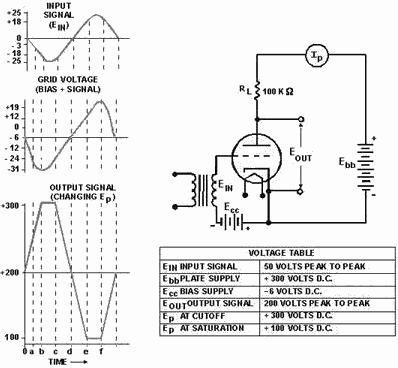
Figure 1-20. - Overdriven triode. On the negative half of the input signal, the grid voltage is made more negative. This reduces plate
current which, in turn, reduces the voltage drop across RL. The voltage between cathode and the plate is thereby
increased. You can see these relationships by following time "a" through the three waveforms.
1-28
Now, let's assume that this particular triode cuts plate current flow off when the grid reaches -24
volts. This point is reached at time b when Ein is -18 and the bias is -6 (-18 and -6 = -24). Plate current
remains cut off for as long as the grid is at -24 volts or greater. With zero current flowing in the plate
circuit, there is no voltage drop across RL. The entire plate- supply voltage, Ebb (300 volts), appears as plate
voltage between the cathode and the plate. This is shown at time b in the output signal waveform. Between time b
and time c, the grid voltage is greater than -24 volts. The plate current remains cutoff, and the plate voltage
remains at +300. The output waveform between time b and time c cannot follow the input because the plate voltage
cannot increase above +300 volts. The output waveform is "flat-topped." This condition is known as
Amplitude Distortion.
When the grid voltage becomes less negative than -24 volts, after time c, the tube starts conducting, and the
circuit again produces an output. Between time c and time d, the circuit continues to operate without
distortion. At time e, however, the output waveform is again distorted and remains distorted until time f. Let's
see what happened.
Remember that every cathode is able to emit just so many electrons. When that maximum number is being emitted, the
tube is said to be at SATURATION or PLATE SATURATION. Saturation is reached in a
triode when the voltages on the grid and plate combine to draw all the electrons from the space charge.
Now, as our grid becomes less negative (between time c and time d), and actually becomes positive (between time d
and time e), the plate current increases, the voltage across RL increases, and the plate voltage decreases.
Apparently when the grid voltage reached +12 volts at time e, the plate current reached saturation. Maximum plate
current (at saturation) results in maximum voltage across RL and minimum plate voltage. Any grid voltage higher
than +12 volts cannot cause further changes in the output. Therefore, between time e and time f, the plate voltage
remains at +100 volts and the waveform is distorted. This is also Amplitude Distortion.
This has been an explanation of one cycle of an input signal that overdrives the tube. You should notice that,
using the same circuit, a 50-volt peak-to-peak input signal caused a vastly different output from that caused by
the 6-volt peak-to-peak input signal. The 6-volt peak-to-peak signal did not overdrive the tube. When the input
signal was increased to 50-volts peak-to-peak, the tube was forced into cutoff when the grid was driven to -24
volts, and into saturation when the grid was driven to +12 volts (the grid voltage plus the signal voltage.)
During these periods, the tube could not respond to the input signal. In other words, the output was distorted. a
method commonly used to partially overcome distortion is to vary the bias voltage on the grid. The point at which
the tube goes into cutoff or saturation can then be controlled. For this reason tube biasing is of great
importance in most tube circuits.
1-29
Q20. The waveforms shown below are the input and output of an overdriven triode.
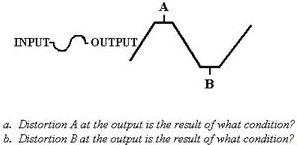 TYPES of BIASING There are two main classes of biasing - FIXED
and SELF. In a tube circuit that uses fixed bias, the grid-bias voltage is supplied from a power
source external to the circuit. You are already familiar with battery bias, which is one form of fixed bias. When
fixed bias is used in a circuit, it can be represented as either a battery (fig. 1-21, view A), or as a conductor
connected to -Ecc (fig. 1-21, view B). Fixed bias is rarely used in electronics today. Therefore, we will not
discuss it further.
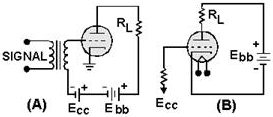
Figure 1-21. - Fixed bias: A. Battery B. Conductor In circuits using self-bias, the bias voltage is developed across a resistor in the cathode or grid
circuit by tube current. There are two main methods of self-bias: cathode biasing and grid-leak biasing.
Cathode Bias In circuits using cathode bias, the cathode is made to
go positive relative to the grid. The effect of this is the same as making the grid negative relative to
the cathode. Because the biasing resistor is in the cathode leg of the circuit, the method is called
CATHODE BIASING or CATHODE BIAS. a triode circuit using cathode bias is shown in figure
1-22.
1-30
| - |
Matter, Energy,
and Direct Current |
| - |
Alternating Current and Transformers |
| - |
Circuit Protection, Control, and Measurement |
| - |
Electrical Conductors, Wiring Techniques,
and Schematic Reading |
| - |
Generators and Motors |
| - |
Electronic Emission, Tubes, and Power Supplies |
| - |
Solid-State Devices and Power Supplies |
| - |
Amplifiers |
| - |
Wave-Generation and Wave-Shaping Circuits |
| - |
Wave Propagation, Transmission Lines, and
Antennas |
| - |
Microwave Principles |
| - |
Modulation Principles |
| - |
Introduction to Number Systems and Logic Circuits |
| - |
- Introduction to Microelectronics |
| - |
Principles of Synchros, Servos, and Gyros |
| - |
Introduction to Test Equipment |
| - |
Radio-Frequency Communications Principles |
| - |
Radar Principles |
| - |
The Technician's Handbook, Master Glossary |
| - |
Test Methods and Practices |
| - |
Introduction to Digital Computers |
| - |
Magnetic Recording |
| - |
Introduction to Fiber Optics |
| Note: Navy Electricity and Electronics Training
Series (NEETS) content is U.S. Navy property in the public domain. |
|






















